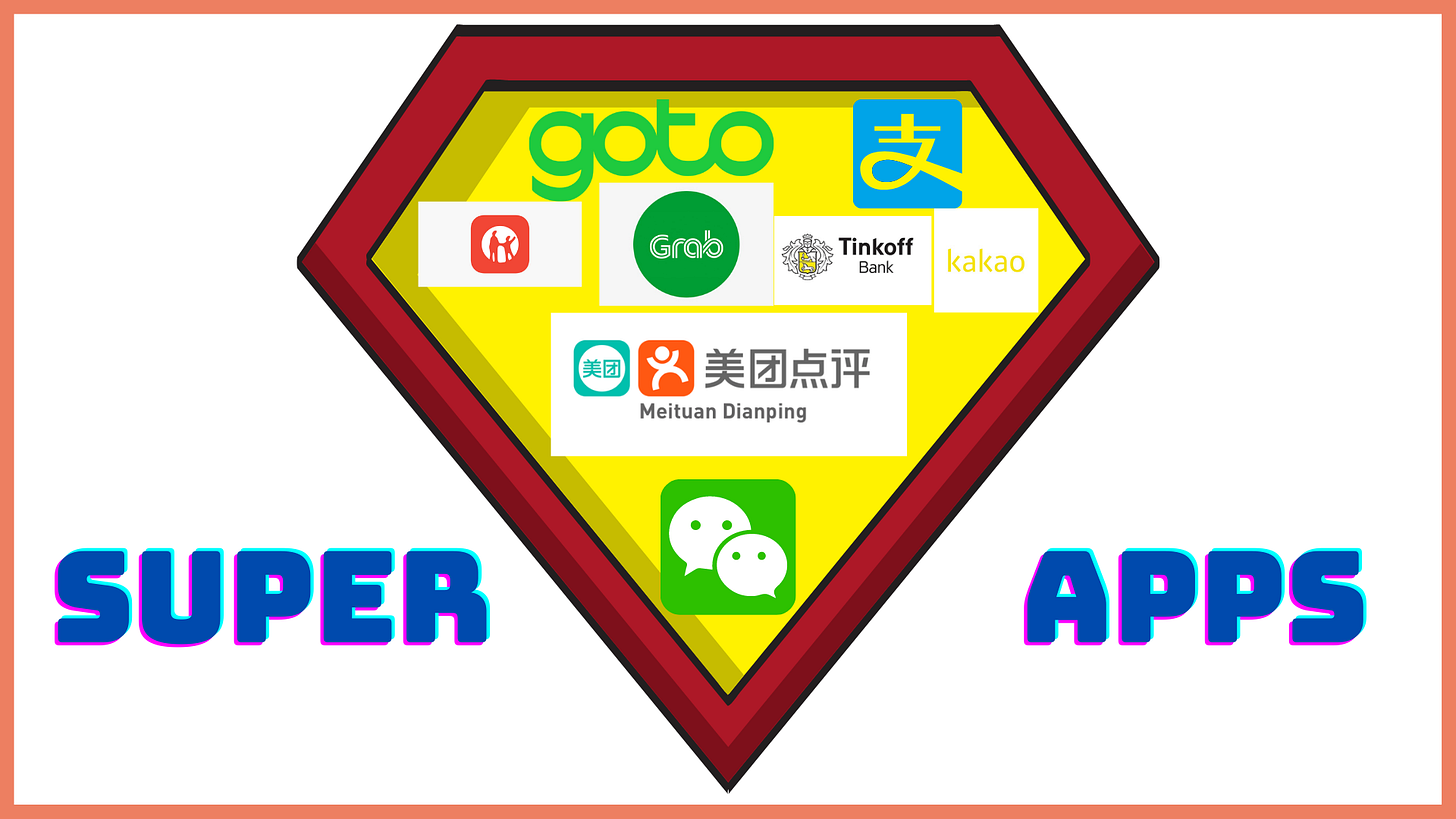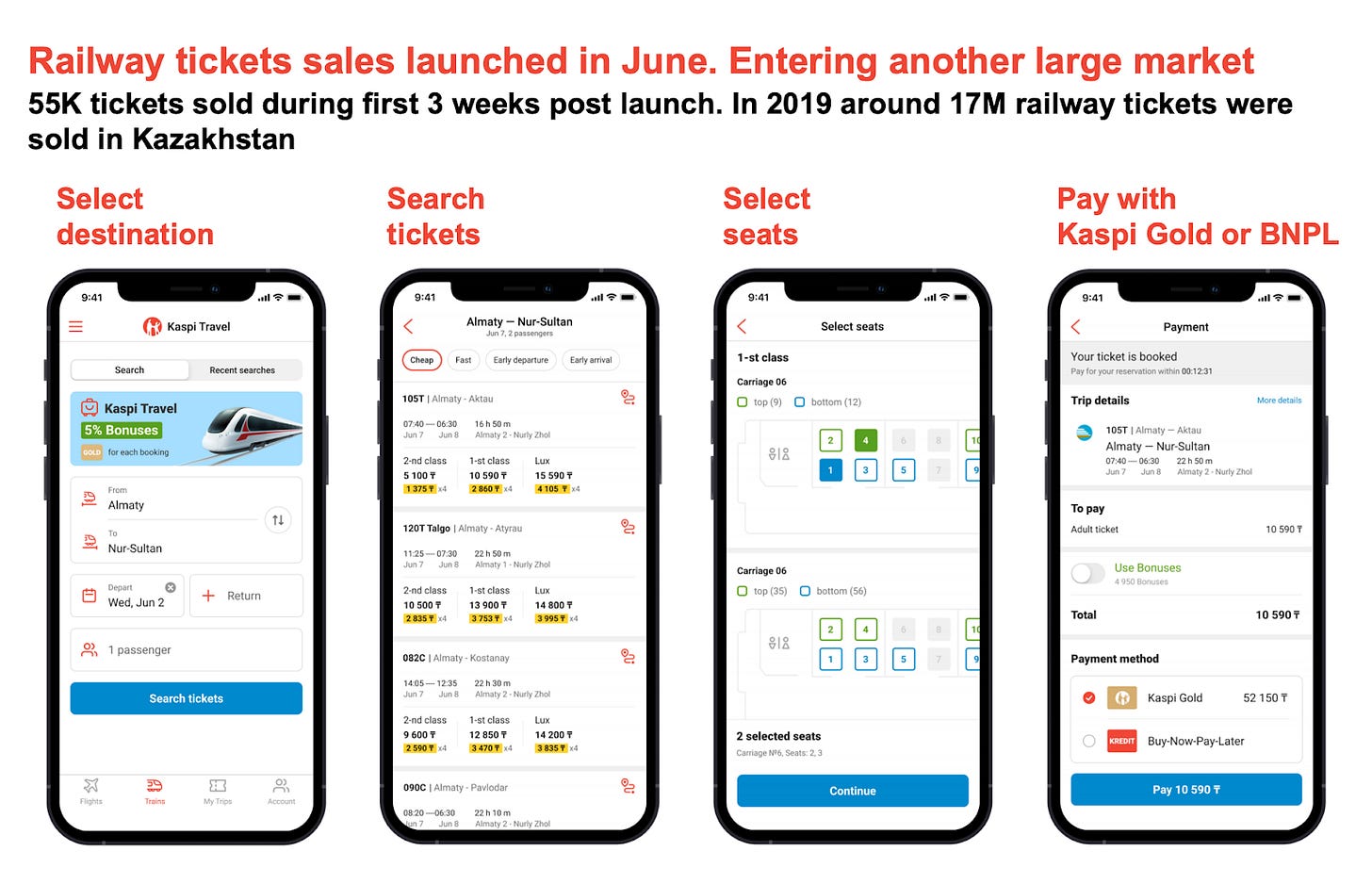#30 Will Super Apps take off in Africa?
Analysing the factors behind the growth of Asian super apps
Hi all - This is the 30th edition of Frontier Fintech. A big thanks to my regular readers and subscribers. To those who are yet to subscribe, hit the subscribe button below and share with your colleagues and friends. 🚀
Introduction
This week, I’m taking a look at Super Apps. Everyone seems to be launching or about to launch one and most Fintechs talk about their long-term product strategy as being a super app. Of course this has piqued my interest and I figured, I’d do some digging to understand what makes a Super app fly. Most successful super-apps such as WeChat, Meituan, Grab and GoTo come from Asia. Eastern Europe and Central Asia also have successful super apps such as Kaspi in Kazakhstan and Tinkoff in Russia. Other examples could include Yandex Go in Russia although it’s still quite early to call Yandex Go a success.
In broad terms, a super-app is an app in which a user can access multiple services through one interface. These services could include, communication, travel, ticketing, health, logistics and shopping.The success of a super-app follows Bill Gates’ platform maxim in which he states “A platform is when the economic value of everybody that uses it, exceeds the value of the company that creates it. Then it’s a platform.” Often they are built on top of one daily life service and then extend thereafter. This life service could be communication, transport, food or shopping/trade.
Super-apps can be designed around “Mini-apps” such as those found on Wechat or they can be designed to be a central hub through which many services can be offered. The latter includes apps such as Tinkoff, Grab and GoTo. From a user perspective, super-apps offer convenience as they enable easier search and discovery often combined with payments. From one app, a customer can manage his/her daily life services and the data therein can be used to further customise and personalise the in-app experience.
Ron Shevlin, a contributor at Forbes and head of research at Cornerstone Advisors talks of payments being the 5th “P” of marketing with the other P’s being Product, Price, Place and Promotion. Super-apps combine all the elements of marketing and add payments.
Commercially, super-apps that gain traction have very useful economics for the promoters. Over the long term, an app can significantly improve its LTV/CAC ratio by adding more services. Meituan for instance benefits from an average of 26 transactions per user per year whereas AirBnB only has 0.5 transactions per user per year on average. This ability to cross-sell and up-sell by Meituan enables it to be more aggressive on customer acquisition. The data and insights generated from the platform then power personalisation and discovery that leads to stickiness. These same dynamics are present with Tinkoff as a finance super app and Kaspi in Kazakhstan which has an average of 39.3 transactions per customer.
Source: Kaspi Investor Presentation
Source: Kaspi Investor Presentation
The screen above shows an example of the user journey when booking train tickets on Kaspi. At the end of the process, the two payment options are both provided by Kaspi including a BNPL later. This shows that Kaspi earns revenues potentially on the ticket commission as well as the payments either as an issuer, through a payment commission or through interest or fees on BNPL.
My approach to this article was to dig into the histories of Meituan, Wechat and Grab and then tease out any central themes from their origin stories that can be extrapolated to other markets. Of course, through the process, learning what works and what doesn’t work.
Meituan Dianping
Meituan is China’s third largest tech company behind Alibaba and Wechat and it’s the 8th largest company in China by overall market capitalisation. Meituan Dianping is the largest marketplace for lifestyle services particularly offline to online services in China. These include movie tickets, meals at restaurants, flights, home delivery services, pharmaceuticals amongst others. It was formed by the merger of two companies Dazhong Dianping and Meituan and was backed uniquely by both Tencent and Alibaba. After the merger though, Tencent became the main backer of Meituan Dianping with Alibaba focusing on Ele.Me, Meituan’s main rival in the O2O space.
To understand it’s origins one has to go back to the history of both Meituan and Dazhong Dianping. Meituan was founded by Wang Xing who is the quintessential entrepreneur. After graduating from Tsinghua University, he travelled to the USA to pursue a PHd in computer engineering from the University of Delaware. An entrepreneurial itch bothered him and he later dropped out to move back to China. He had been inspired by the revolution in consumer software companies in the USA such as Friendster and later Facebook and he saw the massive opportunity back home.
At this time i.e. early 2000s, China was exploding with entrepreneurial energy. Many modern tech giants in China trace their history to this period and were led by Gen X tech founders. Once back in China he built three knock-offs of American tech companies. His first was called “Duoduoyou” which literally meant “many friends” which was modelled on Friendster. He later built a like for like replica of Facebook called “Xiaonei” which also failed. This was followed up by a Twitter replica called “Fanfou” which fell foul of the Chinese government due to politically sensitive content that appeared on the microblogging site.
In 2010, he started Meituan which was modelled on Groupon and was based on the idea of collective bargaining power for group discounts. At the time, there were over 2,000 similar companies in China offering such services including Dazhong Dianping. Meituan piloted its services in Beijing and Shanghai prior to launching in tier 2 and 3 cities across the country. In 2011, Meituan received US$ 100m led by Sequoia and Lightspeed ventures. The company was still burning through cash to achieve scale.
Keep reading with a 7-day free trial
Subscribe to Frontier Fintech Newsletter to keep reading this post and get 7 days of free access to the full post archives.






